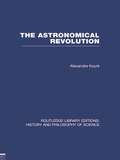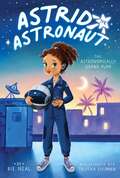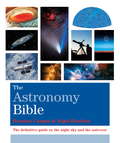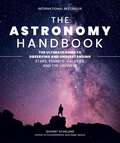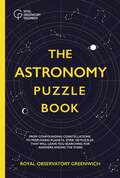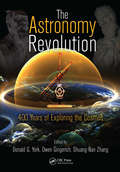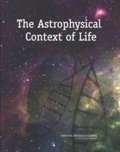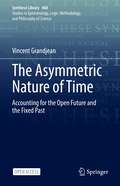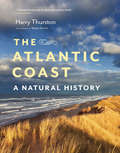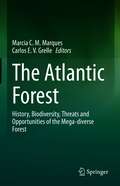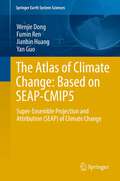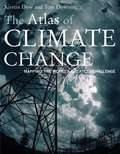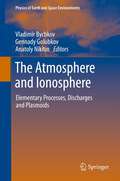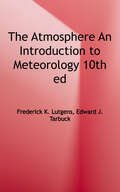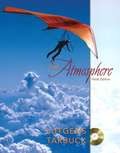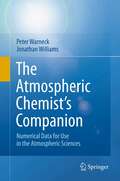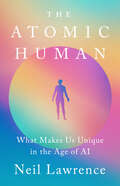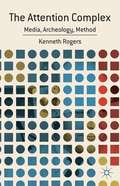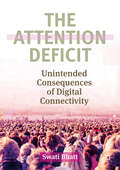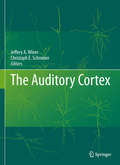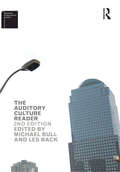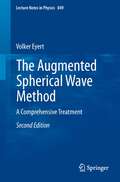- Table View
- List View
The Astronomical Revolution: Copernicus - Kepler - Borelli (Routledge Library Editions: History & Philosophy of Science)
by Alexandre KoyreOriginally published in English in 1973. This volume traces the development of the revolution which so drastically altered man’s view of the universe in the sixteenth and seventeenth centuries. The "astronomical revolution" was accomplished in three stages, each linked with the work of one man. With Copernicus, the sun became the centre of the universe. With Kepler, celestial dynamics replaced the kinematics of circles and spheres used by Copernicus. With Borelli the unification of celestial and terrestrial physics was completed by abandonment of the circle in favour the straight line to infinity.
The Astronomically Grand Plan (Astrid the Astronaut #1)
by Rie NealIn this first book of a brand new-chapter book series, a young girl is determined to be the first astronaut with hearing aids in space!Astrid can&’t wait for the school year to start so she can put her Astronomically Grand Plan into action! She and her best friend, Hallie, are going to be in their first year of Shooting Stars, a club dedicated to all things space. Astrid&’s big sister has told her all about it, and this year, there is a big, wonderful prize: a trip to a real-life space camp! But Astrid&’s Grand Plan isn&’t off to a great start: it turns out Hallie is more interested in the art club, Petite Picassos! And Astrid isn&’t sure that her goal of exploring space will happen the same way without her BFF by her side. Can Astrid figure out a way to complete her mission?
The Astronomy Bible
by Nigel Henbest Heather CouperThis comprehensive guide to astronomy introduces the basic concepts, explaining what, when, and how to observe space, right through to current theories on everything from black holes to microquasars. It helps you to navigate the night sky, identify the constellations and find planets, comets, galaxies and deep-sky objects.Accessible, informative, and fully-illustrated, this is an invaluable practical companion for anyone who loves stargazing.
The Astronomy Bible: The Definitive Guide To The Night Sky And The Universe (Subject Bible Ser.)
by Nigel Henbest Heather CouperThis comprehensive guide to astronomy introduces the basic concepts, explaining what, when, and how to observe space, right through to current theories on everything from black holes to microquasars. It helps you to navigate the night sky, identify the constellations and find planets, comets, galaxies and deep-sky objects. Accessible, informative, and fully-illustrated, this is an invaluable practical companion for anyone who loves stargazing.
The Astronomy Handbook: The Ultimate Guide to Observing and Understanding Stars, Planets, Galaxies, and the Universe
by Govert SchillingThis essential guide for every amateur astronomer explores the entire universe in one practical, easy-to-use, beginner-friendly handbook.The Astronomy Handbook, by award-winning astronomy writer Govert Schilling, is the indispensable, go-to guide to everything you ever wanted or need to know about space, including: the stars and the constellations planets comets eclipses galaxies black holes exoplanets and much more It also offers an excellent education for every amateur astronomer, including detailed and practical information on how to: locate and track the movements of the constellations throughout the year view the planets and the cosmos select the best equipment to use, including telescopes and cameras photograph objects in space Schilling provides a fascinating history of astronomy, as well as clear and accessible explanations of binary, variable, and neutron stars; black holes and gamma-ray bursts; the formation and structure of galaxies; dark matter; and extraterrestrial life.The Astronomy Handbook is a primordial soup-to-nuts guide to the cosmos and an essential reference for every student of the universe.
The Astronomy Puzzle Book
by Dr Gareth Moore Royal Observatory Greenwich__________Pre-order now: the biggest quiz book of 2021. The Astronomy Puzzle Book is a puzzle book that's truly out of this world__________What's Goldilocks got to do with the study of space? Everyone's heard of NASA, but can you name any of the other 72 space agencies around the world? And do you know your lunar and solar deities?The Astronomy Puzzle Book is packed with more than 100 puzzles that have been inspired by the Royal Observatory's history and collections. The conundrums and riddles in this book celebrate all that is inspiring and fascinating about space, the stars and the history of astronomy. Inside this book, you will find astronomical instruments, star charts, famous astronomers and much more. Explore some of the latest astronomical theories and achievements in space exploration as you decipher the clues and solve the puzzles.Put your problem-solving skills to the test by delving deep into the darkest corners of space.__________ Space has the power to inspire and fascinate all of us on Earth and the history of astronomy has been one of solving puzzles. Now it's your turn.
The Astronomy Puzzle Book
by Gareth Moore Royal Observatory Greenwich__________Pre-order now: the biggest quiz book of 2021. The Astronomy Puzzle Book is a puzzle book that's truly out of this world__________What's Goldilocks got to do with the study of space? Everyone's heard of NASA, but can you name any of the other 72 space agencies around the world? And do you know your lunar and solar deities?The Astronomy Puzzle Book is packed with more than 100 puzzles that have been inspired by the Royal Observatory's history and collections. The conundrums and riddles in this book celebrate all that is inspiring and fascinating about space, the stars and the history of astronomy. Inside this book, you will find astronomical instruments, star charts, famous astronomers and much more. Explore some of the latest astronomical theories and achievements in space exploration as you decipher the clues and solve the puzzles.Put your problem-solving skills to the test by delving deep into the darkest corners of space.__________ Space has the power to inspire and fascinate all of us on Earth and the history of astronomy has been one of solving puzzles. Now it's your turn.
The Astronomy Revolution: 400 Years of Exploring the Cosmos
by Owen Gingerich Donald G. York Shuang-Nan ZhangSome 400 years after the first known patent application for a telescope by Hans Lipperhey, The Astronomy Revolution: 400 Years of Exploring the Cosmos surveys the effects of this instrument and explores the questions that have arisen out of scientific research in astronomy and cosmology. Inspired by the international New Vision 400 conference held
The Astrophysical Context of Life
by National Research Council of the National AcademiesIn 1997, the National Aeronautics and Space Administration (NASA) formed the National Astrobiology Institute to coordinate and fund research into the origins, distribution, and fate of life in the universe. A 2002 NRC study of that program, Life in the Universe: An Assessment of U.S. and International Programs in Astrobiology, raised a number of concerns about the Astrobiology program. In particular, it concluded that areas of astrophysics related to the astronomical environment in which life arose on earth were not well represented in the program. In response to that finding, the Space Studies Board requested the original study committee, the Committee on the Origins and Evolution of Life, to examine ways to augment and integrate astronomy and astrophysics into the Astrobiology program. This report presents the results of that study. It provides a review of the earlier report and related efforts, a detailed examination of the elements of the astrobiology program that would benefit from greater integration and augmentation of astronomy and astrophysics, and an assessment of ways to facilitate the integration of astronomy with other astrobiology disciplines.
The Asymmetric Nature of Time: Accounting for the Open Future and the Fixed Past (Synthese Library #468)
by Vincent GrandjeanThis open access monograph offers a detailed study and a systematic defense of a key intuition we typically have, as human beings, with respect to the nature of time: the intuition that the future is open, whereas the past is fixed. For example, whereas it seems unsettled whether there will be a fourth world war, it is settled that there was a first world war.The book contributes, in particular, three major and original insights. First, it provides a coherent, non-metaphorical, and metaphysically illuminating elucidation of the intuition. Second, it determines which model of the temporal structure of the world is most appropriate to accommodate the intuition, and settles on a specific version of the Growing Block Theory of time (GBT). Third, it puts forward a naturalistic foundation for GBT, by exploiting recent results of our best physics (viz. General Relativity, Quantum Mechanics, and Quantum Gravity). Three main challenges are addressed: the dismissal of temporal asymmetries as non-fundamental phenomena only (e.g., thermodynamic or causal phenomena), the epistemic objection against GBT, and the apparent tension between GBT and relativistic physics. It is argued that the asymmetry between the open future and the fixed past must be grounded in the temporal structure of the world, and that this is neither precluded by our epistemic device, nor by the latest approaches to Quantum Gravity (e.g., the Causal Set Theory). Aiming at reconciling time as we find it in ordinary experience and time as physics describes it, this innovative book will raise the interest of both academic researchers and graduate students working on the philosophy of time. More generally, it presents contents of interest for all metaphysicians and non-dogmatic philosophers of physics.This is an open access book.
The Atlantic Coast
by Wayne Barrett Harry ThurstonThe North Atlantic coast of North America-commonly known as the Atlantic Coast-extends from Newfoundland and Labrador through the Maritime Provinces and the Northeastern United States south to Cape Hatteras. This North Atlantic region belongs to the sea. The maritime influence on climate, flora, and fauna is dominant - even far inland. Both on land and at sea, this region is where north meets south, where the great northern boreal forests intermingle with the southern coniferous-hardwood forests, and where the icy Labrador Current and the tropical Gulf Stream vie for supremacy and eventually mix. The Atlantic Coast draws upon the best and most up-to-date science on the ecology of the region as well as the author's lifetime experience as a resident, biologist, and naturalist. The book explores the geological origins of the region, the two major forest realms, and the main freshwater and marine ecosystems, and describes the flora and fauna that characterize each habitat. It ends with a look at what has been lost and how the remaining natural heritage of the region might be conserved for the future.
The Atlantic Forest: History, Biodiversity, Threats and Opportunities of the Mega-diverse Forest
by Marcia C. M. Marques Carlos E. V. GrelleThe Atlantic Forest is one of the 36 hotspots for biodiversity conservation worldwide. It is a unique, large biome (more than 3000 km in latitude; 2500 in longitude), marked by high biodiversity, high degree of endemic species and, at the same time, extremely threatened. Approximately 70% of the Brazilian population lives in the area of this biome, which makes the conflict between biodiversity conservation and the sustainability of the human population a relevant issue. This book aims to cover: 1) the historical characterization and geographic variation of the biome; 2) the distribution of the diversity of some relevant taxa; 3) the main threats to biodiversity, and 4) possible opportunities to ensure the biodiversity conservation, and the economic and social sustainability. Also, it is hoped that this book can be useful for those involved in the development of public policies aimed at the conservation of this important global biome.
The Atlas of Climate Change: Based on SEAP-CMIP5
by Fumin Ren Jianbin Huang Wenjie Dong Yan Guo"The Atlas of Climate Change--Based on SEAP-CMIP5" is intended to satisfy readers' curiosity: how will our climate system change over the next 100 years? It is the first showcase for the state-of -the-art earth system models that released their CMIP5 simulations for the IPCC AR5.The atlas focuses on both the past climate system change from 1850 and the projection of the future climate system change to 2100 using the RCP2.6, RCP4.5 and RCP8.5 scenarios based on climate models. This provides the research and application community interested in the impact of climate change on fields such as agriculture, ecosystem, environment,water resources, energy, health, economy, risk governance and international negotiation, etc. with the newest climate change projection information. Additionally, the atlas will show the historical responsibility of the developed/developing countries and possible contributions to the mitigation of climate change according to their pledge of GHG emission reduction after the Cancun Agreement as an extension numerical experiment to CMIP5 with NCAR's CESM1.0. The authors will update this atlas after future releases of CMIP5 model outputs and update the figures in the second edition of the atlas in 2012-2013. Both Prof. Wenjie Dong and Yan Guo work at the Beijing Normal University, China. Prof. Fumin Ren works at the China Meteorological Administration, China. Prof. Jianbin Huang works at the Tsinghua University, China.
The Atlas of Climate Change: Mapping the World's Greatest Challenge
by Kirstin Dow Thomas E. DowningThis is an essential resource for policy makers, environmentalists, students, and everyone concerned with this pressing subject.
The Atmosphere and Ionosphere
by Vladimir Bychkov Gennady Golubkov Anatoly NikitinThe main topics of the book are the analysis of reactions in the atmosphere-ionosphere system and the influence of natural and technogenic processes on them. The book also examines a range of related research from an international field. In all, five sections of the volume cover the dynamics of atmospheric aerosols; the dynamics of an ionosphere and atmosphere and their communication through an ionosphere; elementary processes in the upper atmosphere and an ionosphere; electromagnetic and optical phenomena in atmosphere, including long-lived and plasma objects; and Information systems of environment monitoring and prevention of incidents. The primary goals of the text are to reveal the interrelations of the dynamics of various atmospheric layers, as well as discovering the parameters of the atmosphere and ionosphere and establishing the role of various physical factors in the phenomena. The aim is to forecast the dynamics of environment in the development of external perturbations.
The Atmosphere: An Introduction to Meteorology
by Dennis Tasa Edward Tarbuck Frederick Lutgens Redina HermanThe Atmosphere: An Introduction to Meteorology remains the definitive introductory meteorology text, reinforcing basic concepts with easy-to-grasp, everyday examples. Authors Tarbuck and Lutgens present meteorology with a friendly, largely non-technical narrative, timely coverage of recent atmospheric events, and carefully crafted artwork by leading science illustrator Dennis Tasa. The 14th Edition includes a new, easier-to-navigate design, and a more reader-oriented approach that provides a clear learning path throughout the text. New pedagogical improvements, including pull quotes that act as guideposts, end-of-chapter questions and problems, and online exercises and activities, are available in Mastering™ Meteorology to help readers understand the processes that control our weather and apply this information in their daily lives.
The Atmosphere: An Introduction to Meteorology
by Edward J. Tarbuck Frederick K. LutgensUsing everyday, easy-to-grasp examples to reinforce basic concepts, this highly regarded handbook remains the standard introduction to meteorology and the atmosphere – components, problems, and applications. Includes the most up-to-date coverage of topics such as: ozone depletion; the ultraviolet index; temperature; dew point temperature and orographic effects; wildfires and weather; thunderstorms and lightning; the record-breaking Florida hurricane season; effects of air pollution, and more. Incorporates top-quality visuals, including new satellite images and illustrations by the award-winning Dennis Tasa, to demonstrate the highly visual nature of meteorology. Uses a largely non-technical writing style to help readers grasp important concepts. For those interested in learning more about meteorology.
The Atmosphere: An Introduction to Meteorology (9th edition)
by Edward J. Tarbuck Frederick K. LutgensA standard textbook presenting a current and comprehensive survey of meteorology for undergraduates.
The Atmospheric Chemist’s Companion
by Jonathan Williams Peter WarneckThis companion provides a collection of frequently needed numerical data as a convenient desk-top or pocket reference for atmospheric scientists as well as a concise source of information for others interested in this matter. The material contained in this book was extracted from the recent and the past scientific literature; it covers essentially all aspects of atmospheric chemistry. The data are presented primarily in the form of annotated tables while any explanatory text is kept to a minimum. In this condensed form of presentation, the volume may serve also as a supplement to many textbooks used in teaching the subject at various universities. Peter Warneck, a physical chemist specializing in atmospheric chemistry, received the diploma in 1954 and the doctorate in 1956 at the university in Bonn, Germany. In 1959, following several postdoctoral assignments, he joined the GCA Corporation in Bedford, Massachusetts, where he explored elementary processes in the atmospheres of the earth and other planets. He returned to Germany in 1970 to head the chemical kinetics group in the Air Chemistry Division of the Max-Planck-Institute for Chemistry in Mainz. In 1974 he also became professor of physical chemistry at the university in Mainz. In 1991, following German reunification, Warneck was appointed the founding director of the new Institute for Tropospheric Research in Leipzig. He served in this position parallel to his activities in Mainz until official retirement. Warneck's research included laboratory studies of chemical mechanisms and photochemistry as well as the development of analytical techniques for field measurements. Since 1990, his interests are focused on chemical reactions in clouds. Jonathan Williams is an atmospheric chemist. He received his BSc in Chemistry and French and his Ph.D. in Environmental Science from the University of East Anglia, England. Between 1995-1997 he worked as a postdoctoral researcher at the NOAA Aeronomy laboratory in Boulder, USA, and from 1998 to present as a member of staff at the Max Planck Institute for Chemistry, Mainz, Germany. He has participated in many international field measurement campaigns on aircraft, ships and at ground stations. Dr Williams is currently an editor on three atmospheric chemistry journals. His present research involves investigating the chemistry of reactive organic species in the atmosphere, in particular over forested ecosystems and in the marine boundary layer. Dr Williams leads a research group focussed specifically on Volatile Organic Compounds (VOC) at the Max Planck Institute and in 2008 he was made an honorary Reader at the University of East Anglia, UK.
The Atomic Human: What Makes Us Unique in the Age of AI
by Neil D. LawrenceFrom a renowned computer scientist, this book seeks the distinctive human quality that will prevail against artificial intelligence. If artificial intelligence takes over decision-making what, then, is unique and irreplaceable about human intelligence? The Atomic Human is a journey of discovery to the core of what it is to be human, in search of the qualities that cannot be replaced by the machine. Neil Lawrence brings a timely, fresh perspective to this new era, recounting his personal journey to understand the riddle of intelligence. By contrasting our own intelligence with the capabilities of machine intelligence through history, The Atomic Human reveals the technical origins, capabilities, and limitations of AI systems, and how they should be wielded–not just by the experts, but ordinary people.
The Attention Complex
by Kenneth RogersOver the past two decades in the United States, a profound reorientation of human attention has taken shape. This book addresses the recent cultural anxiety about attention as a way of negotiating a crisis of the self that is increasingly managed, mediated, and controlled by technologies.
The Attention Deficit: Unintended Consequences of Digital Connectivity
by Swati BhattDigital technology has enabled connectivity on an unimagined scale. Human beings are social animals and economic activity promotes this socialization. Market transactions are based on optimism about the future, faith that the world is good and trust that growth is organic or coming from within the system. Individuals therefore invest in the future by having children, by extending credit and accepting risk, and by building connections with others in the sincere expectation of this connectivity being reciprocated. This book explores the unintended consequences of ubiquitous connectivity. The first effect is captured by the sharing model. Technology offers multiple avenues for sharing experiences and personal information, so active engagement with this increased content uses mental effort. Connection inevitably leads to comparisons with other groups and individuals, so despite the benefits of affirmation and group inclusion, these links corrode social networks, leading to depression and mental apathy. The second effect--the result of the commercialization of sharing--is encapsulated in the attention deficit model. Loss of self-worth, driven by the first effect, encourages further connectivity and sharing as buyers seek more comfort and reassurance via social media, paying with time and personal information. The product is digital content and the payment is with time and data. Correspondingly, social media fulfills this demand with exuberance, both via user-generated content and commercially curated content. We are overwhelmed with even more information, paying with increasingly scarce time and attention. Finally, the third and most consequential effect is diminished risk taking. Attention scarcity, as a consequence of the content tsunami, throttles cognitive effort, impairing judgment and decision-making. So the safe bet may be to do nothing . . . take no risks and no gambles. Weaving together the latest research on economics, psychology, and neuroscience, this book fills a void for readers wanting a smart, clear analysis of communications markets and the commercialization of Internet-inspired connectivity.
The Auditory Cortex
by Christoph E. Schreiner Jeffery A. WinerThere has been substantial progress in understanding the contributions of the auditory forebrain to hearing, sound localization, communication, emotive behavior, and cognition. The Auditory Cortex covers the latest knowledge about the auditory forebrain, including the auditory cortex as well as the medial geniculate body in the thalamus. This book will cover all important aspects of the auditory forebrain organization and function, integrating the auditory thalamus and cortex into a smooth, coherent whole. Volume One covers basic auditory neuroscience. It complements The Auditory Cortex, Volume 2: Integrative Neuroscience, which takes a more applied/clinical perspective.
The Auditory Culture Reader (Sensory Formations)
by Michael BullThe first edition of The Auditory Culture Reader offered an introduction to both classical and recent work on auditory culture, laying the foundations for new academic research in sound studies. Today, interest and research on sound thrives across disciplines such as music, anthropology, geography, sociology and cultural studies as well as within the new interdisciplinary sphere of sound studies itself. This second edition reflects on the changes to the field since the first edition and offers a vast amount of new content, a user-friendly organization which highlights key themes and concepts, and a methodologies section which addresses practical questions for students setting out on auditory explorations. All essays are accessible to non-experts and encompass scholarship from leading figures in the field, discussing issues relating to sound and listening from the broadest set of interdisciplinary perspectives. Inspiring students and researchers attentive to sound in their work, newly-commissioned and classical excerpts bring urban research and ethnography alive with sensory case studies that open up a world beyond the visual. This book is core reading for all courses that cover the role of sound in culture, within sound studies, anthropology, sociology, cultural studies, history, media studies and urban geography.
The Augmented Spherical Wave Method
by Volker EyertThe Augmented Spherical Wave (ASW) method is one of the most powerful approaches to handle the requirements of finite basis sets in DFT calculations. It is particularly suited for the calculation of the electronic, magnetic, and optical properties of solid-state materials. Recent developments allow application, in addition, to the elastic properties and phonon spectra. Due to the localized nature of the ASW basis set these properties can be easily interpreted in terms of atomic-like orbitals. The book addresses all those who want to learn about methods for electronic structure calculations and the ASW method in particular. This new edition has been thoroughly revised and extended. In particular, a chapter on the new, both very efficient and accurate spherical-wave based full potential ASW method has been added.
